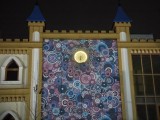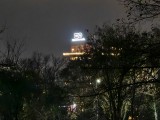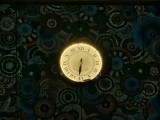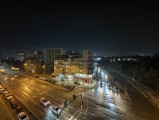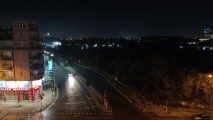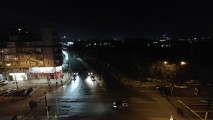iQOO 12 review

Cameras
The iQOO 12 packs what appears to be a flagship-grade camera setup on the back, a kit that has become quite popular lately. There is a 50MP primary camera, a 50MP ultrawide, and a 64MP telephoto for 3x optical and up to 10x lossless zoom. There is a single front camera - a 16MP imager.

The main camera on the iQOO 12 relies on a new 50MP OmniVision OV50H sensor with a large 1/1.3" area and 1.2µm individual pixels; it supports multi-directional Quad-PD autofocus. The sensor sits behind a stabilized (OIS) 23mm f/1.7 lens. There is support for 2x lossless zoom.
Next is the 50MP ultrawide camera, which uses a 50MP Samsung (S5K)JN1 - 1/2.76" size and 0.64µm individual pixels. It is coupled with a 15mm f/2.0 lens, and autofocus is supported, which means you can shoot macro photos.
The third and final camera is the zoom one - it packs a 64MP OV64B sensor - 1/2" size and 0.7µm individual pixels. It sits behind a stabilized (OIS) periscope 70mm f/2.6 lens - again, practically identical to the one found on the OnePlus Open or the Oppo Find N3. This camera offers 3x optical magnification and supports up to 10x lossless zoom. This camera also supports focusing from very close distances, making for some great shots with natural bokeh.
The front camera is the same as on the iQOO 11 - it uses an archaic 16MP Samsung S5K3P9 (1/3", 1µm) with a Tetra-cell filter, but instead of 4MP shots, it saves upscaled 16MP ones (a compromise often made by manufacturers). The sensor has a 27mm f/2.45 lens and the focus is fixed.
Camera app
The camera app is similar to previous iQOO and vivo apps. There's a straightforward zoom selector that gives you direct access to each of the three cameras and their hybrid zoom levels (2x, 10x). Accessing the Super Macro mode is done from the flower icon next to the hamburger menu, but it has an auto-on option, too, that kicks in when you get very close to a subject.

The main modes are arranged in a carousel formation, and you can switch between them by swiping or tapping on one of the visible modes. The More tab lists the rest of the modes, and from there, you can also customize the modes you have available in the viewfinder.
The Pro mode gives you all the freedom to adjust the autofocus, white balance, shutter speed, ISO and exposure. You can do so on all three cameras. There's helpful information explaining all of the options above if you are just getting into photography. Shooting in RAW is also an option.
There are three color modes, with the default one being Vivid. There is also Natural and Textured. The Natural color mode should make for realistic colors, in contrast to the more saturated default Vivid look. The Textured one, also known as Cinematic, offers a more atmospheric and artistic look.
The Portrait mode also includes various effects and styles, and it shoots at 2x zoom by default, but you can switch to 1x or 3x, of course.
Finally, Night Mode is present, and it supports Auto Tripod Night Mode and Panorama Night Mode, as well as a new Astro mode such as Supermoon (a larger and textured moon) and Astro (adds shapes to stars).
Daylight photo quality
The main camera saves 12.5MP photos by default, and those are nicely detailed and sharp, with outstanding dynamic range and superb contrast. The noise is low; the colors are a notch more saturated than reality but not over the top. The overall processing seems pleasing.
There are various imperfections, though. We have observed failed image stacking, especially in areas of high complexity and/or random detail; we even spotted burred rectangles where the processing has failed entirely. Some over-sharpening can be observed as well.
While the errors with the processing aren't getting in the way much, they do account for the not flagship-grade quality we expected the iQOO 12 to offer.
The Natural color mode serves absolutely accurate colors, as promised. It also offers a bit less processed photos with more adequate sharpening and sometimes - higher contrast. It can also resolve the issue with the problematic image stacking and the overall imperfections across the photos.
The textured photos, on the other hand, offer a major boost in saturation, sharpening and brightness. They may not be everyone's cup of tea, but if you like them - you can definitely set the Textured/Cinematic mode as a default one.
The 50MP High-resolution mode will not offer a major breakthrough over the standard Photo mode. It will not wow you with quality - the detail is average, the dynamic range is not that wide, and the colors are rather accurate. But since these photos were not processed, you can downsize them to 12.5MP and get some nicely detailed and realistic images.
The 2x zoom over the main camera is of high quality; it probably uses a crop from the center of the 50MP photo. While the photos have lower per-pixel quality than the 1x ones, they still offer good enough detail, likable colors, wide dynamic range and high contrast. They are a bit noisy, though.
Moving on to the telephoto camera.
The 16MP default 3x zoomed photos are magnificent! They offer a high level of resolved detail, just the right sharpness, lively colors, and low noise. We can also praise the wide dynamic range and overall great contrast.
The 16MP 10x zoomed photos are surprisingly good - their level of detail is unexpectedly alright, even if not on par with the 3x zoom. The overall rendition is proficient with good sharpness, constantly accurate colors, low noise, and wide dynamic range.
We did observe some purple fringing and smeared foliage, but still - some solid shots, ones that would look perfect in 8MP or 10MP resolution instead of 16MP.
The 64MP high-res zoomed photos are okay - they have a good amount of detail, accurate colors and good dynamic range, but they are quite noisy.
The 12.5MP ultrawide photos offer adequate detail and sharpness, even if we've seen better. The noise is low, the colors match the other cameras - meaning they are rather accurate - and the dynamic range is super wide.
The 50MP high-res mode works on the ultrawide camera, but it saves rather poor photos - with a low amount of detail and, sometimes - a lot of noise. They are less processed, of course.
You can get as close as 5cm away from a subject for a macro shot with the ultrawide camera, and usually, you will get a good-looking photo.
But the macro photos from the telephoto camera shot at 3x zoom are the real deal - they have a natural bokeh, better color reproduction, and a sharper and more detailed, often with wider dynamic range, too.
The Portrait mode supports various effects and simulated apertures, and you can use all three cameras for it. The default zoom is 2x, shot with the main camera.
The 2x portraits are of excellent quality - the subject is well-exposed, detailed, and sharp, with natural colors and proficient separation from the background. The simulated blur is excellent.
The same applies to the 1x portraits, too.
The 3x portraits are a bit too close, but they offer the best quality - the most detailed subject, the best separation, and the most likable blur because of the realistic bokeh the zoom camera offers, and the software just needs to tune it a bit more instead of creating it anew.
Finally, the 16MP selfies offer superb exposure, accurate colors and wide dynamic range. But they have been upscaled from 4MP, and the detail is incredibly poor. Here is a suggestion - the Quad-Bayer low-res selfie cameras, especially ones that upscale the photos, should be banned!
Low-light photo quality
The low-light photos taken with the main camera are excellent - the resolved detail is a lot, the exposure is great, the noise reduction does a solid job, and the color saturation is lovely. The dynamic range deserves praise, as there are few, if any, blown highlights.
There is some multi-image stacking involved as we had to wait about a second for the photos to be taken (there is an animation on the virtual shutter).
If you decide on using the Night Mode, it may or may not add an extra second to the simulated exposure so it can offer a slightly brighter photo.
The 2x zoomed photos at night are a simple crop and upscale from the 12.5MP output - their resolved detail is halved, and they are soft and lacking.
The zoomed camera captured great 3x photos - detailed, with low noise, high contrast, wide dynamic, and exposed very well. The colors are great, too.
The 10x photos, while heavily upscaled from the 3x ones, are plenty usable.
The ultrawide photos we took at night are solid as well. Their detail is alright, and we can see some smeared noise, but they are still good with enough detail, great dynamic range, good exposure, okay-ish colors, and an overall realistic look.
Finally, when using Night Mode, there is this option called Automatic Tripod Detection. If enabled, the camera will know when the phone is steady enough for a long exposure shot and will use shutter speeds between 5s and 10s.
The Tripod Long Exposure photos are stunning. They are incredibly detailed, free of noise, with excellent dynamic range and popping colors.

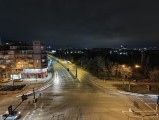
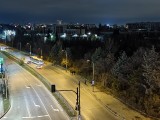

Tripod Night Mode: Main • UW • 2x • 3x
And here's how the main camera stacks up against the competition in our extensive Photo compare database.


iQOO 12 against the Galaxy S23 Ultra and the Xiaomi 13T Pro in our Photo compare tool
Video quality
The iQOO 12 supports video recording on all of its cameras. All three rear cams can shoot up to 4K videos at up to 60fps, while the main cam also supports 8K videos at 30fps.
The selfie camera is limited to 1080p@30fps capturing.
Electronic stabilization is supported across all rear cameras and all frame rates and resolutions but 8K. It can be turned off, or it can be locked to a horizontal line. There is also a Super Steady mode.
The video bitrate is about 50Mbps for 4K and 140Mbps for 8K clips. Audio is recorded in stereo at 250kbps bitrate, and the sound is quite nice.
Main camera
The main camera records 4K daylight videos in acceptable quality, but we expected more. The resolved detail is mediocre, and the picture looks somewhat washed out, and that is our biggest issue. Otherwise, the footage is noise-free, it has lovely colors, wide dynamic range, and good contrast.
The 4K low-light footage has mediocre detail, there is some noise, and the dynamic range is average here. The colors are alright.
The main camera supports 4K30 Night Mode video, and it's amazing - it is bright and detailed, punchy colors, and has an expanded dynamic range. There is some extra noise, but it's quite tolerable. So, even though it's brighter than reality, the Night Mode video is easily our choice here.
The 8K daylight footage looks good, and it's noticeably sharper than the 4K clips if you are watching on at least a 4K TV/monitor.
Unlike daylight videos, in low light, 8K video recording doesn't have any upsides compared to the 4K mode. The 8K videos don't have any higher level of resolved detail and, if anything, the exposure in 8K even seems darker.
The standard electronic stabilization works great on the main camera.
Oh, the 2x zoom mode simply crops and upscales from the regular footage and the day and night videos exhibit poor detail.
Telephoto camera
The 3x zoomed videos from the telephoto camera are great - they have plenty of resolved detail, they are sharp, with accurate colors, high contrast, and wide dynamic range.
The 4K low-light video from the telephoto camera is quite usable - it offers enough detail, realistic exposure and colors, and low noise.
The electronic stabilization works rather well here, too. It does an excellent job when panning, but it is rather good to account for the shake during walking, too.
Ultrawide camera
The ultrawide camera saves very good 4K videos when shot in broad daylight - they are detailed, sharp, with accurate colors, no noise, and wide dynamic range.
The 4K low-light footage from this camera is usable - the noise is tolerable, the exposure while dark is still alright, there is enough resolved detail, and you can see what is happening even if the colors are a bit desaturated.
The electronic stabilization does a marvelous job here, too.
Selfie camera
The selfie camera does not offer electronic stabilization, and the footage is jiggly. Worse, the video is low on detail. The colors are accurate, and the dynamic range is good, but it's still a bad-quality video.
Finally, here are snapshots from all the videos we took.

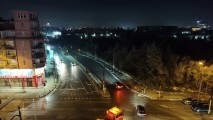
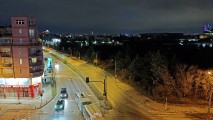
Main 4K: day • low-light • night mode


Main 4K 2x zoom: day • low-light


Telephoto 4K 3x zoom: day • low-light
Here's how the iQOO 12 compares to other devices in our vast video compare database.


iQOO 12 against the Galaxy S23 Ultra and the Xiaomi 13T Pro in our Photo compare tool
Reader comments
- Abhay
- 21 Mar 2025
- rK8
Hey, I am confused between iqoo 12 and oneplus 13r, which is better overall? Which has better camera? Please help.
- Anonymous
- 03 Mar 2025
- 7k3
Try to get the latest one if possible since the price is comparatively same
- Zen Moon
- 28 Nov 2024
- tsP
Incorrect. My iqoo12 always fully charges the battery for 35 minutes


























































































































